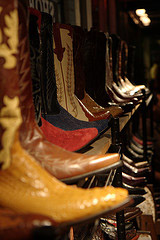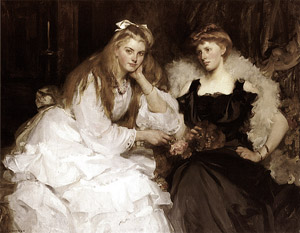Lokan Fashion

Being a fledgling society founded on the last vestiges of a technologically-advanced civilization, Loka has a number of resources at its disposal when it comes to guarding its citizens against biting insects, inclement weather, and of course, immodesty. The clothing patterns viewable in the Castrum’s library, the Athenaeum, provide much of the populace with a way to avoid that caveman-shag look so easily attainable with animal skin. Hundreds of years of living with the Goshorun animal has advanced leather-working to the point that most outerwear today is made with the tough, light hide. It is naturally dark, as the Goshorun is black underneath its sparse, ropey coat of white hair, and most garments made with it are dyed in dark, strong colors or just left black. Tunics and longcoats are common requests in shops and tanneries across Loka.
The plains of Bhuma are a vast source of cotton, as well, which has a wide variety of uses as linen and cotton blends. Sleeved shirts and trousers made from Svargan patterns are common among the general populace, especially in the warmer areas, and the Cela monks of Cetayanti are known for their flowing robes in many rich colors and intricate, artful designs.
Clothing styles here run the gamut. In the cities, many Lokans dress themselves in finery of a modern age: impressive brimmed hats and formal outfits of trousers, tailed jackets, vests, and cuffed shirts. Yet others cling to the Old Ways of Loka’s dark age and wear feathered tricorn hats, leggings, and grand tabards, and tunics of simple design and brilliant, bold colors and symbols. The deserts and plains, however, force ingenuity and functionality on its citizens. Weather-resistant longcoats made from Goshorun hide protect the farmers, ranchers, and hunters from the elements as well as their wide-brimmed hats. The tabards and tunics of the dark-agers have been adapted to tougher materials and intricate Pasu designs, with dazzling stripes and diamonds in dozens of earthy shades.
Weather-resistant longcoats made from Goshorun hide protect the farmers, ranchers, and hunters from the elements as well as their wide-brimmed hats. The tabards and tunics of the dark-agers have been adapted to tougher materials and intricate Pasu designs, with dazzling stripes and diamonds in dozens of earthy shades.

The Sea of Rocana sees its fair share of black market clothing trade as well, where a culture of piracy and heavy commerce blends each fashion together in an environment that can be chilly and waterlogged one minute, and blazingly hot the next. Here the starchy, stiff look of the urban fashion combines tailed jackets and lush vests with the feathered tricorn of the traditionalists and the jackboot of the plainsmen into accouterments that can suit any number of climates.
Svarga
“Svarga” is the Pasu term for the ancient world that existed before the Great War. A highly advanced civilization, Svarga was the progenitor of technology that today’s scientists are only just beginning to understand. Loka is the descendant of that grand people, the phoenix that rose from the ashes of an Armageddon that nearly cast down humanity forever.
No one knows much about Svarga outside of the few traces of scientific progress they left behind. Evidence of the way their culture worked, with what beliefs they held and what they valued, are often sparse at best– the language of the time past left to the study of a select few who have made headway in translation. The amount of still-readable material of their writings is low with most of it having decayed over the years, or stored on devices too advanced for anyone to make sense of it.
Svarga was said to be destroyed by the demon god ‘Dozakh Zulm’. Legend holds that Dozakh was brought forth by Svarga’s insatiable desire for conflict and war, and he rose to put an end to humanity, with all its virtues and flaws. Humans survived the wrath by hiding in bunkers. Dozakh turned the sky to ash, and scorched the ground, killing most of humanity and hunting survivors with highly advanced mechanical warriors. The first of the Cela, among whom was the mighty warrior Skanda, entrapped Dozakh into a metal seal called the Helldoor before retreating with the rest underground, as the air had turned to smoke and the land was turning to ice.
Their eerie ruins litter the countryside, mostly decrepit caverns of steel and darkness, filled with the debris of time and neglect… but the determined explorer may find something extraordinary yet.
Humans
The average human of Loka today is the descendant of the Svargans, the ragged and pale people that emerged from the ruins of the Great War, starving, out of food and desperate for fresh air and sunlight. As they appeared, they were greeted with a wary eye by the Pasu-Abhasa, who had already recolonized the long-desolate battlefield. With hollow eyes of agony and misery, the humans argued their survival and were allowed to live.
Humans have come a long way from the emaciated cave-dwellers that hobbled into the ashen snow and grey sunlight. With their silver tongues and propensity for taking charge, they have proven their worth. Hale and healthy, they have assumed the mantle of technological progress so long ago cast aside by their ancestors, and devised a royal lineage that has ruled the country of Loka for hundreds of years with a fair but firm grip. With the advantage of the city structures and efficient working of economics, humans have been able to thrive to the point of near parity with the Pasu as a whole, making many of the tribes fear persecution, and fueling racial tensions between the two peoples.
The Lokan Royal Family are humans, as are the majority of their court, and of the various Sheriffs and other officials that help to administer the outlying towns and districts. Keen to secure the loyalty of the Pasu and the security of the more remote tracts of land, the King has granted a dazzling array of noble titles to some of the more “reliable” tribal leaders.
Pasu-Abhasa
More than a dozen major tribes are the backbone of the Pasu-Abhasa, comprising hundreds of distinct ethnicities. From the wolf-led Ze’ev clan to the north to the avian clan of the Tseiqami to the south, the Pasu roughly equal in overall population to the humans, and their initial generosity toward humanity was the only reason it exists today. Most of the tribes pay at least nominal homage to King of Loka, or at any rate consider themselves loosely allied. The tribes themselves are often rather loosely organized, with constituent clans acting as they will, and urban or other settled Pasu often have a national tribal affiliation at most. Many minor tribes or independent clans also exist, but are not enumerated here. Prior to the establishment of the Kingdom of Loka, and occasionally since, various leaders have declared themselves leaders of a united Pasu-Abhasa nation, or a large portion of it, often assuming a grandiose title. Generally this has been a short-lived arrangement for the duration of a particular crisis, if not an entirely speculative endeavor.
There is of course a faint undercurrent of resentment among the more traditional Pasu, especially the elders, resentment of scientific progress and of the manifest destiny nature of humanity itself. Many Pasu feel that reigniting the lust for the advancement of technology will lead to another Great War, a war that no one will survive a second time. Some of them go so far as to sabotage human vehicles and industrial projects from time to time, which has engendered a racial mistrust in some cities that has led to several battles over Pasu urban access and civil rights.
Technology
Loka is marked by a bewilderingly wide range of technologies. At the time of its founding, the Pasu tribes generally had lifestyles that were based either on hunting or on pastoralism, with technological development to match. While some have eagerly adopted agriculture or industry, many prefer their ancient way of life, modified by technology only insofar as they chose to trade for such items.
Much of rural Loka has a decidedly “pioneer” feel to it, with rugged settlers struggling against the hostile elements, and dealing with the sometimes-suspicious natives. Left to their own devices, much of the farmers’ technology is little better than medieval in places, jarringly juxtaposed with the occasional bought-in steam-powered device, or the very occasional fully-working Svargan artefact.
The cutting edge of contemporary Lokan technology is a mix of recovered Svargan devices and steam-powered machines designed and built by Lokans a few hundred years after their discovery by the Pasu. The Naraka corporation proudly markets their latest ultra-compact oil-fired high-pressure steam engines, used to power the airships and the latest automatic carriages.

Although Svargan artifacts are extremely advanced, they are typically in extreme disrepair or in various stages of decay and corrosion, which renders them inoperable at best, and frequently obliterates any faint hope of ever discovering their original function. A few work perfectly, but are so advanced that no modern Lokan can even begin to understand the essentials of their operation. Most notable amongst these are the handful of artificial intelligences that exist, generally contained in some kind of automaton. Lokan engineers’ zeal to dismantle and experiment with these is tempered only by the disastrous lack of success that the few previous attempts have met with. Perhaps surprisingly, some Svargan technology has proved relatively easy to study, or at least to replicate in part. Many of the advances in steam power were aided by study of ancient artifacts which integrated that as a means of power. This has puzzled many: the Svargans evidently had access to much more advanced sources of power. Some have speculated that a contingent of the Svargans, anticipating their own demise, constructed such devices to withstand the impending disaster, or perhaps to instruct future generations.
Items of particular interest are the so-called “Soul Gems”, purple shards of crystal, that have arcane etchings visible in their centers when held by a light. Rumors abound about these: they are often said to be fuel sources for Svargan automatons, or else that they encode their intelligence, or the principle of vitality, or similar. Wilder stories claim that the Gems actually contain unborn souls, or the essences of living beings that have been extracted and stored in crystalline form. One certainty is that there exists a ready, if clandestine, market for these. Adventurers returning from the ruins will generally find themselves covertly approached by shadowy figures and offered large sums for them — and not a few have been robbed, or assaulted for such treasures. No-one is entirely sure what the eventual destination is, but popular theories mention the Academy, the pirates, and crazed lone scientists.